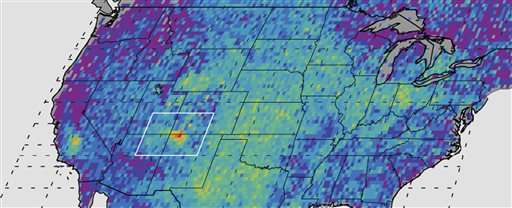Scientists seek source of giant methane mass over Southwest

Scientists are working to pinpoint the source of a giant mass of methane hanging over the southwestern U.S., which a study found to be the country's largest concentration of the greenhouse gas.
The report that revealed the methane hot spot over the Four Corners region—where Colorado, New Mexico, Utah and Arizona meet—was released last year.
Now, scientists from the University of Colorado, the University of Michigan, the National Oceanic and Atmospheric Administration and NASA are conducting a monthlong study to figure out exactly where it came from.
The answer could help reduce methane emissions that contribute to global warming. Here are some key things to know:
___
HOT SPOT
Last year's study by NASA and the University of Michigan was based on images from a European satellite captured between 2003 and 2009. They showed the methane hot spot as a red blip over the area, which is about half the size of Connecticut.
The study found the concentration of methane detected there would trap more heat in the atmosphere than all the carbon dioxide produced each year in Sweden.
Methane doesn't last as long in the atmosphere as carbon dioxide, but it's far more potent for capturing heat in the short term.
___
POSSIBLE SOURCES
Methane occurs naturally and also is emitted by landfills and the agricultural and oil and natural gas industries.
One possible source of the hot spot is methane released from the region's coal deposits.
The releases can happen naturally, especially where coal seams reach the earth's surface. They also occur deliberately when energy companies extract methane—the primary component of natural gas—from coal beds.
The region is home to the San Juan Basin, North America's most productive area coal bed methane extraction area.
Methane also is released by coal mining and oil and gas drilling systems, and cattle produce large amounts of the gas. Scientists can pinpoint the kind of methane created by fossil fuels by looking for the presence of associated hydrocarbons.
___
HEALTH EFFECTS
The methane emissions pose no direct safety or health risks for Four Corners residents, although the hot spot does factor into overall global warming.
Also, methane emitted from traditional oil and gas operations usually is accompanied by hydrocarbon emissions that can create ozone, a pollutant that leads to smog and is linked to asthma and respiratory illness.
___
INVESTIGATING THE MYSTERY
For the next month, scientists based in Durango will fly in planes with a variety of instruments that can sense methane in the San Juan Basin. Crews in vans will follow up on their leads on the ground.
The European satellite that captured the hot spot is no longer in use, but Japan's GOSAT satellite plans to focus in on the Four Corners when it passes over the area.
It's possible methane levels over the Four Corners have changed since 2009, said Gabrielle Petron, a scientist at the University of Colorado's Cooperative Institute for Research in Environmental Sciences who is working on the latest study. Coal bed methane operations have declined since then, but oil production has increased.
© 2015 The Associated Press. All rights reserved.
















